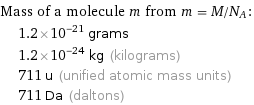Input interpretation

ammonium hexabromoplatinate | molar mass
Result

Find the molar mass, M, for ammonium hexabromoplatinate: M = sum _iN_im_i Plan: • Write the chemical formula and gather atomic masses from the periodic table. • Determine values for N_i and m_i using these items. • Finally, compute the mass. Write the chemical formula: (NH_4)_2PtBr_6 Use the chemical formula to count the number of atoms, N_i, for each element: | N_i Br (bromine) | 6 H (hydrogen) | 8 N (nitrogen) | 2 Pt (platinum) | 1 Look up the atomic mass, m_i, in g·mol^(-1) for each element in the periodic table: | N_i | m_i/g·mol^(-1) Br (bromine) | 6 | 79.904 H (hydrogen) | 8 | 1.008 N (nitrogen) | 2 | 14.007 Pt (platinum) | 1 | 195.084 Multiply N_i by m_i to compute the mass for each element. Then sum those values to compute the molar mass, M: Answer: | | | N_i | m_i/g·mol^(-1) | mass/g·mol^(-1) Br (bromine) | 6 | 79.904 | 6 × 79.904 = 479.424 H (hydrogen) | 8 | 1.008 | 8 × 1.008 = 8.064 N (nitrogen) | 2 | 14.007 | 2 × 14.007 = 28.014 Pt (platinum) | 1 | 195.084 | 1 × 195.084 = 195.084 M = 479.424 g/mol + 8.064 g/mol + 28.014 g/mol + 195.084 g/mol = 710.586 g/mol
Unit conversion

0.71059 kg/mol (kilograms per mole)
Comparisons

≈ 0.99 × molar mass of fullerene ( ≈ 721 g/mol )

≈ 3.7 × molar mass of caffeine ( ≈ 194 g/mol )

≈ 12 × molar mass of sodium chloride ( ≈ 58 g/mol )
Corresponding quantities

Mass of a molecule m from m = M/N_A: | 1.2×10^-21 grams | 1.2×10^-24 kg (kilograms) | 711 u (unified atomic mass units) | 711 Da (daltons)

Relative molecular mass M_r from M_r = M_u/M: | 711